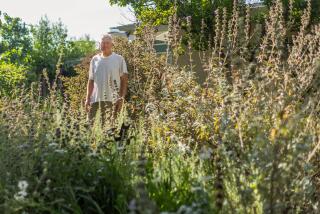Master gardener program goes for a crop of volunteers
- Share via
When Yvonne Savio switched one basic criterion in the selection process for applicants to the UC Cooperative Extension Master Gardener Program in 2001, the results were impressive. Instead of recruiting gardeners interested in volunteering, she started looking for volunteers interested in gardening, specifically growing edible plants in organic gardens for low-income communities.
“We train volunteers,” says Yvonne Savio. “We give the more sophisticated knowledge of gardening, the resources. I’m not teaching you everything about gardening. I’m teaching you where to go to look for the answers about any questions that you might get from your gardeners.”
California natives and drought-tolerant ornamentals are also included in the master gardener curriculum, but the emphasis for the last 20 years has been on how to grow food for home consumption. That meant teaching smart watering, composting, companion planting, pest and weed control, and recycling everything and anything for the garden: kids’ milk cartons and plastic strawberry baskets for seedlings, torn women’s hosiery for melon supports, bread package twist ties for staking tomatoes.
The number of projects initiated by L.A. master gardeners tops the totals of other California counties and even those of many states.
Last year, L.A. master gardeners logged more than 20,000 hours at 269 locations, giving advice to more than 140,000 Los Angeles County residents.
Nobody, it seemed, could grow gardener volunteers like Savio, but the 2015 class is her last as program coordinator. The woman responsible for much of the program’s success has just retired.
Savio grew up in Pasadena and still lives there — with her husband, Tom, a railroad historian, in the house her parents built on a hillside and terraced with fruit trees, vegetables and roses.
In the mid-1980s, Tom became the assistant curator at the California State Railroad Museum in Sacramento while Yvonne worked for the YWCA in Sacramento and then the UC Davis Cooperative Extension office dealing with statewide growing of tomatoes, potatoes, onions, garlic, cool-season crops, harvesting and processing.
She also started freelance writing about gardens, relying on a stack of gardening columns she had cut out of the Sunday Los Angeles Times Magazine.
At nurseries in Davis, she encountered other like-minded gardeners who also were searching for edibles they could grow at home and something more tasty than the flavorless produce found in markets.
With the support of the Yolo County Cooperative Extension advisor, they set up their own master gardener program, one of only a few in the state.
When a job opened up in 1994 to coordinate the restart of the moribund L.A. master gardener program, Savio jumped at the chance to move back home.
She teamed up with food banks, such as Senior Gleaners and Second Harvest, that were focused on getting
food to people. Together they created the Los Angeles Community Garden Council, a nonprofit dedicated to supporting community gardens in Los Angeles County (their two newest, Willowbrook Community Gar-
den and Eastmont Community Garden, opened last month).
But during the first few years of master gardener classes, the students were often retirees or garden club members who didn’t necessarily volunteer, especially in urban neighborhoods. Savio’s boss, Rachel Surls, sent her to visit community gardens to look for a different type of trainee.
During 2000, Savio visited 60 community gardens, searching for would-be master gardeners. Fifty sent students.
“That’s what started this synergy between master gardeners and community gardens,” she says. “We in L.A. are completely different from other [master gardener programs] statewide in that we allow people to develop their own projects. We have had the special distinction in specializing in edibles, school gardens and low-income folks. As much as we’re known for doing this wonderful stuff, it’s not within the purview of other master gardener programs.”
The master gardener program will continue, with Surls at the helm.
::
Options for those interested in master gardener programs
More than 200 people typically apply for the 50 spaces in the annual Los Angeles master gardener program classes, held every Saturday in March through May.
There is another option: the Grow L.A. Victory Garden classes, a four-class version of the program. The Grow L.A. classes are led by certified master gardeners and are generally given during three months in the spring and three months in the fall. They are open to everyone throughout Los Angeles County. There’s one in June in Beverly Hills at the Greystone Mansion. The schedule and locations of classes is available at the UC Cooperative Extension website, celosangeles.ucanr.edu.
The primary resource and textbook for Master Gardeners is the massive 750-page “California Master Gardener Handbook.” Originally published in 2002, the book has received a design makeover for the just-released second edition with a slightly larger font, updated tables and color photos and drawings. It also includes new material on invasive plants, garden design principles and landscaping for fire protection. (www.anrcatalog.ucanr.edu)
For a video visit through Yvonne Savio’s Pasadena backyard and some of her best recycling-in-the-garden tips, check out Huell Howser’s 2004 visit.
Savio’s blog, gardeninginLA.com, is expected to go live the first week of this month.
Jeff Spurrier was in the 2010 group of master gardeners.
Twitter: @latimeshome






